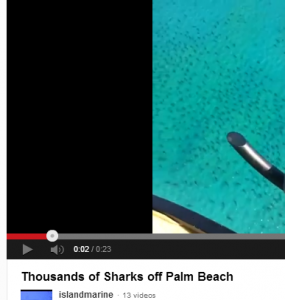Blackfin and spinner sharks are passing by Palm Beach, FL, this time of year–so many and so flamboyantly you may be able to see them from the shore.
“They like to stay in shallow water and with bait fish,” says Shari Tellman, a graduate student who has been researching the sharks at Florida Atlantic University’s Elasmobranch Research Laboratory in Boca Raton. For the last two years, professor Steven Kajiura has organized Cesna flights along the shore of Palm Beach County all year to count the number and kind of sharks that visit.
The sharks have been coming for a long time but researchers want to get a better picture of how many visit now in case rising global temperatures or offshore development changes their patterns. At their peak, blacktips and spinners number about 15,000 sharks in the area, Kajiura, told the
Treasure Coast Palm. That translates to about 1,000 sharks per square km or one about every 60 feet, he said.
Some years people seem to see more sharks, but that may be just because rough water hides them, Tellman says. “In years past I remember being able to sit on the beach and jump the entire day.”
Video this year shows them jumping in water only a foot or so deep. The sharks can close beaches–at spring break!–but many people are excited to get to see sharks.
The sharks jump among surfers. They may have accidentally hit or bit some swimmers, but they are not after people in any way, Tellman says. They hunt tiny fish and don’t confuse humans for their target–unlike the great white shark, say, that might mistake a surfer for a seal. The worst part of the encounter may be a scrape from their rough skin or an infection from their unwashed teeth, she says. “They have pretty dirty teeth and that can lead to a pretty nasty infection,” Tellman says. (Other scientists are studying the kind of bacteria that thrives in their mouths.)
Both species, which are hard to tell apart until they are adults (and even then, only if you’re an expert on their fins), have the amusing habit of twirling around as they catch small fish and propel themselves out of the water, spinning up to three times. Both spinners and blacktips are near-threatened, according to the IUCN red list. They hang out near the shore, which makes them targets for fishermen–mostly hobbyists, but also those hunting for shark fins for China. Confusingly,
spinners (Carcharias brevipinna) are sometimes called blacktips, even though that is a different species
(Carcharhinus limbatus). The sharks are migrating through and will spend the summer along the east coast. (They have similar patterns off Africa and Europe.) The sharks, which average about 6 feet, mate in early summer then carry the young 12-15 months and give birth to 3-15 pups that are already a couple feet long. Because the US shark population is in decline, the inland shark nurseries are important. Oddly, the sharks don’t entertain residents on the way down south. Tellman says the current may make them travel far from shore.
Tellman has another Florida shark watching tip: off Jupiter scuba divers can see lemon sharks. Normally sharks flee from the bubbles of scuba tanks, but these don’t seem to mind.
Where to see animals down south
Related posts:


Recent Comments